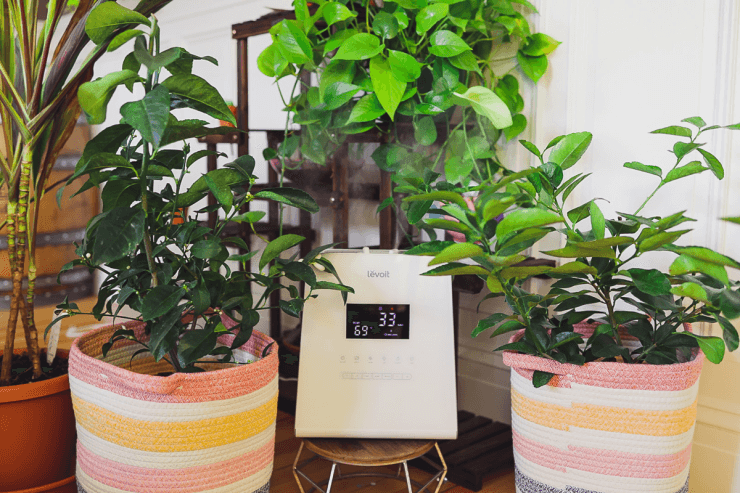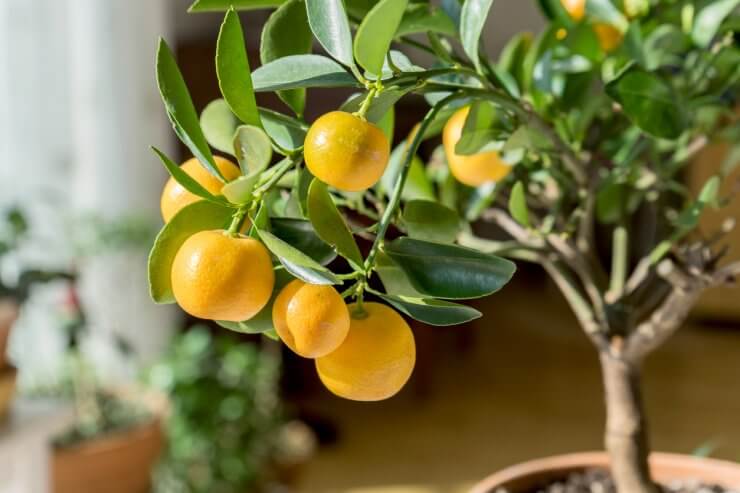
Your indoor citrus trees have a thing or two to say about your relationship. Don’t take this the wrong way; they appreciate what you do for them. But unless you make some changes, this isn’t going to last.
I’ll admit, putting this resource together for you was a little selfish on my part. I have recently jumped back into the circus that is trying to grow indoor citrus trees while living in a cold-weather climate. Our February 2022 issue of Food Gardening Magazine inspired me because we have created a whole collection on growing oranges. I’ve been down this road before and got sloppy when summer came around, but this time it’ll be different, I’m sure of it!

Meet Betty and Veronica. Betty, my Meyer lemon tree, is full of the most intoxicating blossoms. Veronica, my Persian lime tree, might need another year.
I bought my latest pair of citrus trees at a local gardening center because shipping is a bit harsh on the plants. The woman in the gardening center said that citrus trees like humidity so much that if given the choice, they’d prefer to be on a cool damp porch or in the basement (above 65 degrees F), than in a warm but dry room. I think that’s a mistake a lot of us make, thinking our citrus trees just want to be warm when what they really want is humidity.
Citrus trees enjoy the sunshine and fresh air, which is why I have always put mine outside in the summer. They enjoy the warm days and the cool rains of summer. But getting your citrus trees to create fruit in the winter takes work all year. Maybe you already know that. And look, your indoor citrus trees really do like you. They want this relationship to work. They love the way you smile when you look at them and hold their leaves in your hand, even when you crush up a lime leaf or two for the intoxicating scent or a recipe. Still, something is usually missing if they’re looking a bit unhappy.
Explore the easiest fruit to grow at home—indoors or out! Read our FREEBIE 15 Easiest Fruits to Grow at Home, right now!

Learn how to keep your indoor citrus trees happy and healthy
I completely understand the desire to have indoor citrus trees. There’s nothing like a little tropical color in your kitchen to brighten up a cold winter day. They smell great, look great, and the fruits are delicious. It also helps that January through March is generally when citrus trees fruit, so you get a little gardening joy in the dark days of winter in your indoor container garden. Citrus, however, are not typically cool weather trees. So if you’re growing indoor citrus trees in cold dry winter, it takes extra love.
There are some exceptions. Satsumas and kumquats can withstand below-freezing temperatures and are a little more tolerant of just about everything. For the most part, however, citrus trees would be happy if they could spend the winter in Florida. Since most of us aren’t going to pack up our Meyer lemon tree and head south for the winter, it’s important to keep some essential care tips in mind.
1. Citrus trees need sunshine. Most require at least 8 hours of sunlight daily. That means your indoor citrus trees need to be near a south-facing window.
2. Citrus trees need warmth. You don’t need to crank your heat to 90, but if you expect your citrus trees to thrive indoors, you’ll need to keep the heat around 65, dropping it by 5 to 10 degrees overnight.
3. Citrus trees need water. Not many surprises here. Moist, but well-drained soil. Maybe even let it dry a bit between waterings. Cactus and succulent mix tend to be a good choice here, they want chunky soil.
4. But not too much. That means not too much water or too much dry. You do not want root rot. Ideally, give your indoor citrus trees a big ole drink of water, let the soil dry out, then repeat. And don’t leave extra water just sitting in the saucer. You can add stones to the bottom of your saucer, which will absorb moisture and add to the humidity surrounding the plant.
5. Not too cold, either. One more water tip – don’t pour icy cold mid-winter tap water into your citrus tree soil. You don’t want a cold shower, and neither does your tree. Use room temperature water; otherwise, you could shock the tree.
6. Use a humidifier. If I haven’t stressed it enough, they love and need humidity, so in the winter you’ll need to keep a humidifier (or two) running in the room you’re keeping your citrus trees. Mine do really well with a warm mist humidifier, the difference was visibly noticeable when I switched. If you don’t have a humidifier, give ’em a spritzer. No, not the kind with wine and club soda. That’s for you. But your citrus will need a daily spritz of water to keep from drying out.
7. Feed the tree. If your indoor citrus trees are actively growing, give them a little nutrient boost with a fertilizer designed specifically for citrus. Citrus trees get fertilized three times per year (winter, late spring, and late summer). See our Collections for guides on fertilizing different types of citrus.
8. Watch for pests. Yeah, citrus trees are susceptible to pests just like any other indoor plant. Scale and aphids are fairly common. However, some homemade insecticidal soap will usually take care of these pests.
9. Be the pollinator. If your tree is indoors year-round, you may need to give it some help with pollination if it’s not self-pollinating. It’s easy, though. Just give the branches a little shake when the flowers are open.
10. Move ’em out. Once warm weather rolls around, try to give you indoor citrus trees some outdoor time. When you have regular temperatures of at least 50 degrees overnight, start giving your citrus time outside, slowly building up to leaving it outdoors. It might take a couple of weeks to do this, but your tree will love you for it and you’ll reap the benefits in the next growing season.
Do you have any indoor citrus trees? What tips would you add to this?
Explore the easiest fruit to grow at home—indoors or out! Read our FREEBIE 15 Easiest Fruits to Grow at Home, right now!





My Meyer lemon and yuzu trees have done well inside and out. Perhaps too well. Over the 5 years I’ve owned they’ve grown and I repot them in larger pots each fall, as they seem root-bound. Do you have advice on how to keep them healthy but the same size? They are now hard to lift to move and block a lot of my window. Thank you.
To keep your trees from growing too tall you should prune them regularly in late winter or early spring. Remove longer branches and pinch back new grow to encourage a more compact plant.
Do you have any advice on keeping a kumquat outside over winter? I’m in zone 8, South Carolina.
Kumquats are considered hardy to zone 8. Make sure to mulch base to protect the roots and if you are expecting a severe temperature drop you can protect your plant with a frost cloth or burlap.
I have had some grapefruit trees started from seed about 10 years ago…still no fruit. I put them outside in summer. One has lost most of its leaves…I think it might have been sitting in water. root rot?! is there a cure for that? And I haven’t been fertilizing so that may be a problem.
The most reliable way to tell if your tree has root rot is to inspect the roots. Healthy roots should be white or tan, and firm and flexible. Rotten roots will be brown or black, mushy or slimy and may have a sour, musty or rotten smell. You may be able to save your tree by washing off the soil and trimming off all rotted roots. Re-pot the tree using a well-draining citrus soil mix. As for fertilizer, apply a slow release citrus fertilizer every 4-6 weeks during the growing season only.
I’m year 2 of a mail order Meyer lemon. She was kind enough to to give me 2 juicy lemons in March. Now there are dozen baby lemons starting and it’s May. My question is pruning. She has a thin trunk and several branches that have long thorns and no buds. All the branches that are producing don’t have thorns. Should I cut those off?? I live in the Northwest and just starting to put her outside for a few hours during the day now that it’s in the high 50s to mid 60s.
The best time to prune is late winter, early spring. Since its a young tree, you should only prune to remove dead or damaged branches and to thin out crowded areas. Young Meyer lemons often have thorns – they are nature’s way of protecting them from hungry animals. Eventually the branches will become less thorny. If your tree is grafted and the thorny branches are below the grafting union, then the thorns are likely from the rootstock and can be removed.
We had 2 trees while in north TX that did beautifully. Moved to WV and planning to put 2 in the greenhouse we just built. Any thoughts on that greatly appreciated!!!
I scored, and have 12 small myers lemons which I planted and am raisirising
I have an Orange tree grown from a seed. It was a gift. It needs shaping as it is gangly. How do I prune it?
Here is an interesting article on pruning an orange tree.
https://www.gardeningknowhow.com/edible/fruits/oranges/pruning-orange-trees.htm
I have had a lemon tree for several years and for the last two I have been blessed with a couple of lemons. But the trunk of the tree is very thin. Is there anything I can do to help it to grow? It appears too thin to support more than one fruit at a time.
Quite often a lemon tree will grow tall and skinny in its search for sunlight. You should keep it outside as much as possible so it gets natural light and if you move it indoors due to freezing temperatures, then try placing it in a south facing window.
We are trying to grow lemon trees from seed. Most germinate pretty quickly, but in a month or two many die off. Their leaves get brown edges and the stem eventually gets brown and dries up. How can I keep the ones with lots of leaves and growth from doing the same?
There are SO many factors that you might be running into. Firstly, I applaud you for trying to grow from seed, because it’s certainly a practice in patience and you may not see lemons for five years or more. My best advice is to give your seedlings as much sunlight as possible and keep them in a space with a temperature around 70 degrees Fahrenheit. As they grow, you may need to transplant them a few times, though they do like tight roots. The brown stem tells me maybe they are getting root rot? They like well-draining loose chunky soil, not general potting mix. I mix potting mix 50/50 with succulent mix for mine. If you’re a member of our site, you can access our Lemon Collection which is an entire guide on growing lemons: https://foodgardening.mequoda.com/toc/collections-tart-tangy-lemon-guide/ I hope some of this helps, good luck!